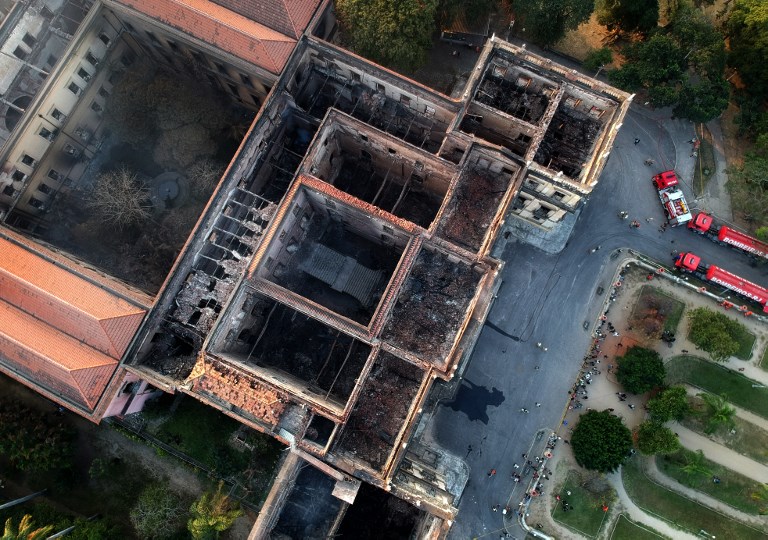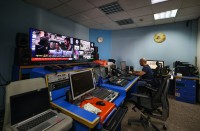
The majestic edifice stood engulfed in flames as plumes of smoke shot into the night sky, while firefighters battled to control the blaze that erupted around 2230 GMT. Five hours later they had managed to smother much of the inferno that had torn through hundreds of rooms, but were still working to extinguish it completely, according to an AFP photographer at the scene. / AFP PHOTO
RIO DE JANEIRO, Brazil (AFP) — Brazil’s National Museum, ravaged Sunday by a massive fire, is Latin America’s largest natural history and anthropology museum, with more than 20 million artefacts and 530,000 titles.
Marking its 200-year anniversary in June, it was founded in 1818 by Portuguese King Joao VI and has been installed since 1892 in a former royal palace.
It sits in the Quinta da Boa Vista public park in the north of Rio de Janeiro, former palace gardens that now include the city’s impressive Zoological Garden.
The museum has about 150,000 visitors a year, according to its website, and has become an important centre of research and learning, integrated since 1946 into the Federal University of Rio de Janeiro.
Palace to scientific treasure chest
The residence of the Portuguese royal family in the early 1800s and then the Brazilian imperial family, the Saint Christopher Palace is 11,400 square metres (123,000 square feet) in area, around a third of which is dedicated to exhibition halls.
From 1889 to 1891 the neoclassical building hosted the assembly that wrote Brazil’s first constitution; in 1892 it took in the royal museum, previously situated in central Rio, which included collections — notably Egyptian — acquired by the Portuguese royal family.
The library contains 537,000 works of which 1,560 are rare.
Dinosaurs and other lost species
The museum is particularly reputed for the richness of its paleontology department with more than 26,000 fossils, including a dinosaur skeleton discovered in Brazil’s central Minas Gerais and several specimens of species that have now disappeared, like giant sloths and sabre-toothed tigers.
It is also home to the largest meteorite discovered in Brazil, named “Bendego” and weighing 5.3 tons.
Its biological anthropology section includes the oldest human fossil found within today’s Brazilian borders, known as “Luzia”.
With more than 6.5 million specimens, the zoology department includes an exceptional collection of fish (600,000) and amphibians (100,000), as well as molluscs, reptiles, shells, corals and butterflies.
The herbarium, created in 1831, has 550,000 plants.
– Venerated research institute –
Dedicated since the 19th century to research, the National Museum is the oldest scientific institution in the country and started teaching in 1927.
Researchers and laboratories occupy a large part of the building and it has over the past century developed a policy of international exchanges, learning and publication of research.
Important scientific figures have visited, including Albert Einstein and Marie Curie.
Budget cuts and an earlier disaster
The museum has suffered budget difficulties in recent years, closing temporarily in 2015 because of maintenance issues, Culture Minster Sergio Sa Leitao said Sunday.
In August 1995 the building suffered serious damage after storms led to flooding in the archeology department, notably damaging 3,000-year-old Egyptian mummies and causing parts of a tyrannosaurus skeleton to dissolve.
Sources: AFP, National Museum website www.museunacional.ufrj.br
© Agence France-Presse






